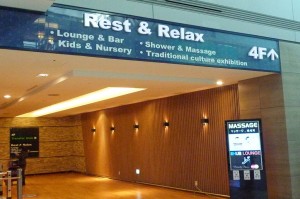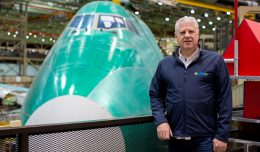For a whole host of reasons, airports are often bewildering, maddening places. There is much to be found in the modern day terminal to enrage, confuse, or vex the traveler. Where to begin?
Consider, for instance, the widespread phenomenon of teenage girls carrying gigantic fluffy pillows onto airplanes. When did this start, and how did it become so popular? Almost as confounding is the mania of Sudoku, this generation’s answer to crossword puzzles and what often seems to be the number one pastime of bored flyers. However, the most alarming trend to strike airports in the past half-century has nothing to do with games, pillows, suicide hijackings or erotic pat-downs from TSA. No, the most troubling thing about airports is noise.
If American airports need to borrow one idea from their counterparts in Europe and Asia, it’s that passengers need not be assailed by a continuous loop of useless and redundant public address announcements. Security alerts, boarding calls, traffic and parking directives — all playing simultaneously. At some airports, this sonic layering is unbearable. I have heard up to four announcements playing at once, rendering all of them unintelligible in a hurricane of noise.
Intensifying this bombardment are the common gate-side televisions blaring CNN Airport Network. Somewhere out there is a survey in which a majority of travelers insist that they enjoy and appreciate the chance to watch TV at the gate. But a license to entertain and a license to harass are different things. These yammering hellboxes are everywhere, and they cannot be turned off. There is no button, no power cord, and no escape. Not even airport workers know how to shut them up. Every gate has one, and they run 24 hours a day. Then you’ve got the shrieking kids, the beeping carts, the cellphone chatter and so on. It’s a multi-front attack that, short of applying headphones or earplugs is inescapable, seeping into every nook and corner of the terminal, at all hours of the day or night.
The following list was inspired by a layover I spent not long ago at Incheon International Airport (ICN), serving Seoul, Korea. Not to take away from perennial survey-toppers like Amsterdam’s Schiphol or Singapore’s Changi Airport (amenities at Changi include a movie theater, a swimming pool and a butterfly garden), but Incheon stands as the most functional, attractive, and overall flyer-friendly airport I’ve ever visited. It’s cavernous and immaculate, with a cathedral-like calm throughout. Security and immigration are a breeze; international transit is effortless. The staff at the multilingual information desks are disarmingly helpful. Amenities include free internet, free showers, luggage storage, cellphone rental desks, a post office and massage facilities. Relaxation areas, with sofas and easy chairs, are set away from the main thoroughfares. There’s a cultural center, a museum, and a full-service hotel inside the secure zone, allowing with extended layovers to rent a room without the need to clear immigration. Or, if you’re feeling energetic, a tour desk arranges free excursions to Incheon city. If you’re headed into Seoul, the airport’s high-speed rail connection will have you downtown in under an hour. Why can’t every airport be like this?
Here are 15 things no airport terminal should be without.
1. A fast, low-cost public transportation link to downtown.
In a way, choosing a favorite airport is like choosing a favorite hospital: amenities aside, nobody really wants to be there in the first place, and the easier and faster you can get the hell out, the better. To that end, every terminal should have a public transport links similar to those across Asia and Europe. The examples of Portland, Oregon and Washington-Reagan notwithstanding, rail links in the United States aren’t nearly as convenient – when they exist at all. At my hometown airport (Boston Logan), my six-mile commute to the airport by public transportation takes almost an hour and requires two changes, including a ride on the Silver Line bus, which in addition to being at the mercy of automobile traffic requires, at one point, that the driver step out and manually switch power sources. Or how about JFK, where for hundreds of millions dollars the AirTrain was finally completed — an inter-terminal rail loop that connects only as far as the Queens subway. It can take 45 minutes, up and down a Rube Goldberg assembly of escalators, elevators and passageways, just to get from one terminal to another, let alone all the way to Manhattan.
2. In-transit capabilities
It’s a shame that American airports cannot, for whatever reason, recognize the “in transit” concept. In the United States, all passengers arriving from other countries, even if they’re merely passing through on the way to a third country, are forced to clear customs and immigration, collect and re-check their luggage, and pass through security screening. It’s an enormous hassle, unheard of in most of the world. And it costs our airlines millions of annual customers. Why change planes in the US, where you’ll have to stand in three different lines, be photographed and fingerprinted, re-check your bags and face the TSA gauntlet, when instead you can transfer seamlessly in Frankfurt or Dubai? Indeed this is part of what has made carriers like Emirates, Singapore Airlines and others so successful.
3. Complimentary wireless internet
What do we do at airports? We kill time. And there are few better and more productive ways of killing time than logging on to the web. Send an email to your mistress; read my blogs, Skype your friend in Slovenia. Many if not most major terminals do have wi-fi access, but it’s often expensive and cumbersome (few things in life are more irritating than those credit card payment pages). It should be everywhere, and it should be free.
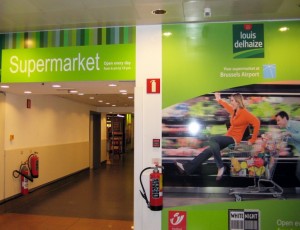
At Brussels Airport in Belgium, travelers can visit the supermarket for last-minute grocery items. (Photo courtesy of the author)
4. Convenience stores
It appears the evolution of airport design will not be complete until the terminal and shopping mall become indistinguishable. I’m okay with Starbucks and souvenir kiosks, but it’s the saturation of high-end boutiques that always confounds me. Apparently there isn’t a traveler alive who isn’t in dying need of a hundred-dollar Mont Blanc pen, a remote-control helicopter or a thousand-dollar massage chair. And what’s with all the luggage stores? Who on earth buys a suitcase after they get to the airport? What we really need are the same sorts of things we buy at CVS or the corner convenience store: basic groceries and dry goods, stationery and personal care items. Brussels and Amsterdam are two that do this right, with in-terminal food marts and pharmacies.
5. Power ports
I didn’t realize that passengers have a right — nay, a duty — to mooch free electricity from their carrier of choice, but at this point it’s a lost cause to argue. Airlines should throw in the towel and build more charging stations.
6. Showers and a short-stay hotel
Another amenity that is common overseas but sorely lacking in North America. No serious international terminal should be without a place to wash up or crash for a few hours. Passengers arriving from overseas can shower and change before their next connection. Those with longer waits can grab a nap in one of those pay-by-the-hour sleeping pods.
7. Play areas for children
Truth be told, airport play areas encourage toddlers to shriek and yell even more than they already do, but at least they’re doing it in a localized area that’s easy for the rest of us to avoid. Ideally, this spot should be in a soundproofed bubble six miles from the airport, but a space at the far end of the concourse is a reasonable alternative. The Delta terminal in Boston has a pretty cool kidport, but nothing tops the “Kids’ Forest” at Amsterdam-Schiphol. I’d play there myself if nobody was watching.
8. Better dining options — i.e. fewer chain restaurants
Chick-fil-A, Burger King, Sbarro’s. Airport cuisine isn’t a whole lot different from the shopping mall food court. We need more independent restaurants serving actual food, ideally with a local bent.
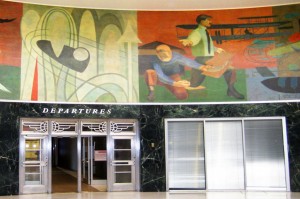
The rotunda inside LaGuardia’s Marine Air Terminal includes the famous Flight mural painted by James Brooks in 1952. (Photo courtesy of the author)
The next time you’re at LaGuardia, check out Rocco Manniello’s Yankee Clipper restaurant over at the Marine Air Terminal. That’s the circular building with the art deco doors and flying fish relief along its rooftop, adjacent to the Delta Shuttle. Rocco’s is a cafeteria-style place on the left-hand side of the rotunda. It’s good greasy spoon food with absolutely no corporate affiliation. (If Anthony Bourdain ever does a segment on airport food, Rocco’s should be his first stop.) The Marine Air Terminal was the launching point of the first-ever transatlantic and around-the-world flights, and the restaurant’s walls are decorated with historic photographs. You can eat in, or take your sandwich out to one of the wooden benches beneath the famous James Brooks “Flight” mural. Commissioned in 1952, Brooks’ painting traces the history of aviation from mythical to (then) modern, Icarus to Pan Am Clipper. The painting’s style is a less than shy nod at Socialist realism, and at the height of ’50′s McCarthyism, in a controversy not unlike that surrounding Diego Rivera’s famous mural at Rockefeller Center, it was declared propaganda and obliterated under gray paint. Not until 1977 was it restored.
9. An information kiosk
Where is the Yankee Clipper restaurant? Where is the nearest ATM? Where is the nonexistent subway link to the city? Every arrivals hall ought to have personnel who can give directions, hand out maps and make change.
10. A bookstore
Reading on planes is a natural, am I right? Why then is it so hard to find a proper bookstore at an airport? (Not all of us pre-load our reading material on a Kindle.) Not long ago, every major airport had a proper bookseller. Nowadays they are harder and harder to find, and usually what passes as a bookstore is really just a newsstand hawking a thin selection of business books, thrillers and pop-culture trash. Believe it or not, travelers’ tastes extend beyond Sudoku, Suze Orman, and the latest CEO autobiography.
11. Sufficient gate-side seating
If the plane at the gate holds 250 people, there ought to be a minimum of 250 chairs in the boarding lounge. There is something uncivilized about having to sit on the floor while waiting to board. Do we sit on the floor when waiting for a table in a restaurant, or at the doctor’s office? When Changi was built in Singapore, the gates were outfitted with no fewer than 420 chairs, matching the number on the average 747.
12. Escalator etiquette
Americans haven’t figured out how to behave on an escalator. If you’re not in a hurry, stand on the right and enjoy the ride, allowing those of us with a flight to catch to walk on the left. Instead we stand in the middle, taking up both sides. Ditto for moving sidewalks. The point of the moving sidewalk is to expedite your passage, not to indulge your laziness. You’re not supposed to stand on it, you’re supposed to walk on it. And to take yet another page from the Europeans and Asians, what prevents us from fitting escalators and sidewalks with a light-beam trigger that shuts off the motor when nobody is on them? Our conveyors run constantly, riders or no riders, wasting huge amounts of energy.
13. A view
Why are so many architects intent on hiding the fact that airports are actually airports? Gateside seating always faces away from the windows, and the windows themselves are sometimes intentionally opaque or obstructed by barriers. Why? Plenty of people would enjoy the opportunity to sit and watch the planes go by. You needn’t be an airplane buff to find this relaxing, or even a little exciting. As a bonus, more windows mean more natural light — always welcome over harsh fluorescents.
Here in Boston there was once a spectacular observation deck on the 16th floor of the control tower. It featured opposing sides of knee-to-ceiling windows and the best view in town. It’s a scant two miles from Logan’s perimeter seawall to the center of downtown, and you observed the city and its airport in a state of working symbiosis. Passengers relaxed on carpeted benches while kids and families came on the weekends, feeding coins into the mechanical binoculars and picnicking on the floor. It made the airport a destination unto itself, like a park or a museum, and encouraged a kind of civic togetherness seldom seen any more. You can still find observation decks here and there, usually in Europe. Boston’s was shuttered in 1989, ostensibly for security reasons.
14. Bring back the air stairs!
Have you ever taken a good look at a jet bridge (or Jetway to use the proprietary term), that strange umbilicus connecting terminal to fuselage? One thing to notice is how ridiculously overbuilt they are. Do we really need all of that metal and cable and wire and hydraulics for what is, at heart, a simple gangway?
Of course, I am opposed to jet bridges on principle. I prefer the classic, drive-up air stairs. Some of the international stations I fly to still employ those old-timey stairs, and I always get a thrill from them. There’s something dramatic about stepping onto a plane that way: the ground-level approach along the tarmac followed by the slow ascent. The effect is like the opening credits of a film — a brief, formal introduction to the journey. By contrast, the jet bridge makes the airplane almost irrelevant; you’re merely in transit from one annoying interior space (terminal) to another (cabin).
Save your emails. This is just me being romantic. The benefits to the jet bridge are obvious — inclement weather, disabled passengers, etc. – and I realize there’s no going back.
15. Last but not least, some aesthetic flair
If an airport has one aesthetic obligation, it’s to impart a sense of place: you are here and nowhere else. On this front, Europe and Asia again set the standard. I think of Lyon and its magnificent hall by Santiago Calatrava, or Kuala Lumpur with its indoor rainforest, and a dozen places between, where terminal design is a point of expressive pride — where it makes a statement, be it quietly stylish or architecturally stupendous.
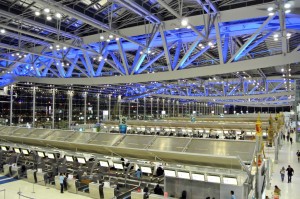
Suvarnabhumi Airport’s central terminal in Bangkok, Thailand is a spectacular vision of glass, light and steel. (Photo courtesy of the author)
Take the magnificent Suvarnabhumi airport (pronounced “Su-wanna-poom”) in Bangkok, Thailand. Its central terminal is the most visually spectacular airport building I have ever seen. At night, as you approach by highway from the city, it looms out of the darkness like a goliath space station — a vision of glass, light and steel, its immense transoms bathed in blue lighting. Or for sheer character, try the little airport in Timbuktu, Mali. Here you’ll find a handsome, Sudanese-style building emulating the mud-built mosques ubiquitous in that country.
With scattered exceptions (Denver, San Francisco, Washington, Vancouver), there is nothing comparable in America. To the contrary, some of our most expensive airport renovations have been terrible disappointments. JetBlue’s wildly overrated home at JFK, for example. Terminal 5 – or “T5” as the carrier likes to call it — is a $743 million, 72-acre structure that opened in 2008 to considerable promotion and fanfare. Inside, the atrium food court and rows of shops conspire to make yet another airport feel like yet another mall. The wi-fi is free, and so is the noise and claustrophobia at the overcrowded gates. But it’s the exterior that’s the real tragedy. Although the street-side facade is at worst cheerless, the tarmac-side is truly abominable — a wide, low-slung, industrial-brutalist expanse of concrete and gray. Once again it looks like a shopping mall. Or, to be more specific, it looks like the back of a shopping mall. All that’s missing are some pallets and dumpsters. The facility’s only visual statement is one of not caring, a presentation of architectural nothingness, absolutely empty of inspiration — precisely what an airport terminal should not be. Is this the best we can do?
It’s ironic that Eero Saarinen’s landmark TWA “Flight Center” sits directly in front of T5, itself part of the JetBlue complex. The TWA building is supposed to serve as an entryway lobby and ticketing plaza for T5, though for now it remains semi-derelict and only partly renovated. I wish they’d finish it so that more people could appreciate what is arguably the most architecturally significant airport terminal ever constructed. Regarded as a modernist masterpiece, the Flight Center opened in 1962 and was the first major terminal built expressly for jet airliners. Saarinen, a Finn whose other projects included the Gateway Arch in St. Louis and the terminal at Washington-Dulles, described his TWA as “all one thing.” The lobby is a fluid, unified sculpture of a space, at once futuristic and organic. It’s a kind of Gaudi inversion, a carved-out atrium reminiscent of the caves of Turkish Cappadocia, overhung by a pair of cantilevered ceilings that rise from a central spine like huge wings.
And just to the north of T5 used to be the National Airlines “Sundrome,” designed by I.M. Pei. It opened in 1970, and was named in honor of National’s yellow and orange sunburst logo and its popular routes between the Northeast and Florida. After National was folded into Pan Am, the terminal was taken over by TWA. Later it was used by JetBlue, then abandoned and torn down.
Pei and Saarinen, a half-minute walk from each other. Our airports ain’t what they used to be.
(View the author’s video of BKK airport.)
This article was originally published on AskThePilot.com and is used here with the author’s permission. Patrick Smith is an airline pilot, air travel columnist and author behind the site AskThePilot.com. In his spare time he has visited more than 70 countries and always asks for a window seat. He lives in Somerville, Massachusetts.



